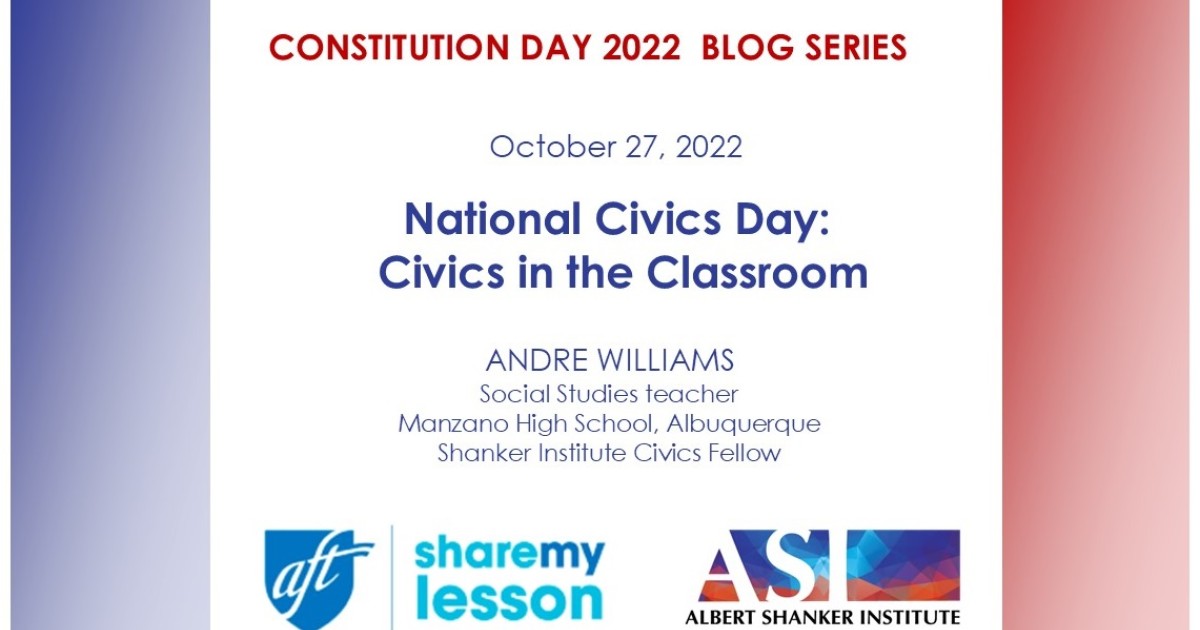Today is National Civics Day. For the last year the Albert Shanker Institute has been working with a team of accomplished educators to create high quality civics and democracy lessons, written with state standards in mind, to share with educators via our partnership with ShareMyLesson. While an unproductive debate about what to teach our students simmers across the country, these lessons serve as an example of how seriously teachers take their responsibility to create healthy teaching and learning environments and lessons where students are introduced to founding documents, like the US Constitution, and the honest history of our country in ways that foster critical thinking. Today we wrap up our 2022 Constitution Day blog series with one example of how these lessons are framed to give readers a glimpse of the work our educators do in their classrooms to meet the academic expectations of students. For more lessons and examples, please visit our Educating for Democratic Citizenship Community on ShareMyLesson.
— Editor
One of the ways teachers can incorporate civics into the classroom is through lessons centered around the Constitution. I like to use lessons that encourage creativity and collaboration. Students are more inclined to participate if they are given a voice in the classroom. What follows is an idea for a lesson on the Constitution that encourages collaboration and engagement.
Jigsaw Done Right
When done correctly, a Jigsaw allows students who are usually quiet an opportunity to express themselves. In my opinion this is the most important aspect of a Jigsaw. I suggest creating a Jigsaw that includes the Bill of Rights and have students not only research but also express their views on these fundamental guarantees listed in our Constitution. In completing the Jigsaw, students will have more in-depth knowledge of the Constitution while benefiting from exposure to diverse views or perspectives. Jigsaws serve as a microcosm of the democratic process and therefore are an ideal introduction to the Constitution for the classroom.
How to Implement Jigsaw with Google Docs
- Break up the Constitution into subtopics. An example could be the Bill of Rights, 20th century amendments, powers of Congress, and Reconstruction Amendments.
- Now that you have 4 or more subtopics, discuss with your students the areas of focus for each subtopic. Narrow their research with essential questions or main ideas.
- Have students (in groups of 4) discuss amongst themselves which subtopic they prefer to research.
- Give students appropriate time to research their subtopic and require them to take appropriate notes. Let each student know that they will be sharing their findings with an “expert group”.
- Have students break into their expert groups and assign a facilitator for each group. The facilitator’s job is to ensure each student presents their research for 2-5 minutes. Students can also share their opinion or perspective on the subtopic. All students are encouraged to listen, take additional notes, and ask questions.
- Have each expert group create a shared Google doc with the title of their subtopic. List 5-10 main ideas they feel are essential to understanding the subtopic. After deliberation the main ideas are prioritized and students prepare an identical presentation to take back to their original group.
- In their original groups students share out with each other. Questions are asked to check for understanding of each subtopic. Each student presents for a minimum of 5 minutes. Once presentations are completed another shared doc is created but this time the doc is populated with notes from each subtopic.
- Create an assessment using the main ideas and essential questions presented at the beginning of the Jigsaw.
- Have students reflect on the Jigsaw process with opportunities of constructive criticism and feedback for their peers.
I have found that students enjoy the social and collaborative nature of Jigsaws. It gives my marginalized and otherwise quiet students a voice. The requirements of Jigsaw are designed for an equitable experience. In regards to the Constitution, Jigsaw allows for a discussion of a diverse set of high-level ideas with peer-assistance and collaboration built-in.
For resources on correctly implementing a Jigsaw please see https://www.Jigsaw.org/






More Stories
How Busy Parents Can Unlock Extraordinary Growth in Their Child’s Education
How Special Needs Advocates Empower Families
Why Special Needs Preschools Are Essential for Growth